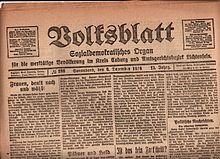Coburger Volksblatt
The Coburger Volksblatt was a daily newspaper from Coburg .
Foundation and first years
The first issue of the Volksblatt, an independent organ for the working population in the Reichstag constituency of Coburg , was published on March 24, 1912 as an agitation number to gain readers. From April 1, 1912, the Volksblatt appeared on working days.
The publication of this newspaper was decided by a shop steward meeting of the social democratic state association for the Duchy of Saxony-Coburg chaired by Karl Wöhner, after the SPD MP Fritz Zietsch was defeated by the national liberal candidate Hermann Quarck in the Reichstag elections in January 1912 . It was financed through the issue of interest-bearing share certificates. The profit made by the Volksblatt went to the SPD of the Coburg region.
It was also decided to found their own print shop and the print inventory of the democratic citizens' newspaper in Sonneberg was acquired for 8,000 Mk . On March 1, 1912, the establishment as an OHG with the company Bruno Körschner & Co in Coburg, printing and publishing house of the Coburger Volksblatt (owner Bruno Körschner and August Neumann in Coburg). A seven-person press commission was formed and Franz Klingler was unanimously elected as the editor in charge . From 1912 to 1914 there were several libel trials against the Volksblatt and prison sentences had to be served. In 1914 the edition was 3,200. During the First World War, the newspaper had to be subsidized by the party executive.
Ernst Florschütz, later Bruno Körschner, and from November 27, 1917 until the end of the war, the printer Max Baudler took over the representation of the editor Klingler, who was called up for army service.
Weimar Republic
After the revolution of 1918/19 the newspaper called itself "Volksblatt", including "Coburger Volksblatt", a social democratic organ for the working population in the Free State of Coburg. In 1920 the circulation was 8,700, in 1925 6,870. Since July 1, 1925, the title was "Coburger Volksblatt".
The rented rooms at Gerbergasse 6 were terminated on January 1, 1924. The publishing house therefore proceeded to erect a new building at Schenkgasse 17, which was officially moved to on March 21, 1925. Printing started there from March 2nd. The self-chosen motto was "Knowledge is power" and was attached to the facade of the building.
The newspaper fought hard against the National Socialist movement and party under its editor-in- chief Franz Klingler, especially in elections. Some articles in the Coburger Volksblatt were even printed by the national social democratic press because of their absolute uncompromising nature. In the 1932 presidential election, the Volksblatt fought for democracy and against Hitler. In 1932 the edition was 7,200.
Short term was Otto Voye responsible for the Journal from July 1, 1931 to November 1, 1932nd Franz Klingler - in poor health - was temporarily responsible for politics and miscellaneous things from all over the world, Otto Voye for local things and everything else. From November 1932, Franz Klingler took over the chief editor again. The circulation of the newspaper was around 8,500 after 1918 and over 7,000 by 1930.
National Socialism
After the transfer of power to Adolf Hitler (January 30, 1933), a series of political messages from the NSDAP had to be recorded. In February 1933 the Volksblatt was banned for 14 days. By the censorship of the NSDAP significant cuts have been made in the text, so that the newspaper often with white spots appeared.
On March 9, 1933, the day of the “second seizure of power” in Coburg , the SA and SS dragged books, brochures, pictures and flags out of the editorial building of the Volksblatt. Public burns were staged on the streets. The swastika flag was forced to fly on all the buildings of the workers' organizations. The last edition appeared on March 14, 1933.
On May 2, 1933, the SA forcibly occupied the publishing house and closed the business. The 38 employees were dismissed without notice, the publishing house was expropriated and the rotary press, which had been destroyed in the attack, was sold to a scrap dealer. One of the victims was the publishing accountant Josef Stenger, who was unable to find a new job until 1935 because of his social democratic stance. In the register court the people sheet was registered on 28 April 1933 as confiscated.
After the Second World War , the SPD was compensated and bought the property on Sonntagsanger 9 in Coburg.
literature
- Alfred Sauerteig : Coburg newspaper history. Veste-Verlag, Coburg 1949.
- Anton Großmann: Milieu conditions of persecution and resistance using the example of selected local SPD associations. In: Bavaria in the Nazi era - 5. The parties KPD, SPD, BVP in persecution and resistance. Ed .: Martin Broszat , Hartmut Mehringer, R. Oldenbourg Verlag Munich Vienna 1983, ISBN 3-486-42401-7 .
- Günther Schmehle: Coburg and the German labor movement . Dissertation to obtain a doctorate at the University of Bamberg, Bamberg 1980


